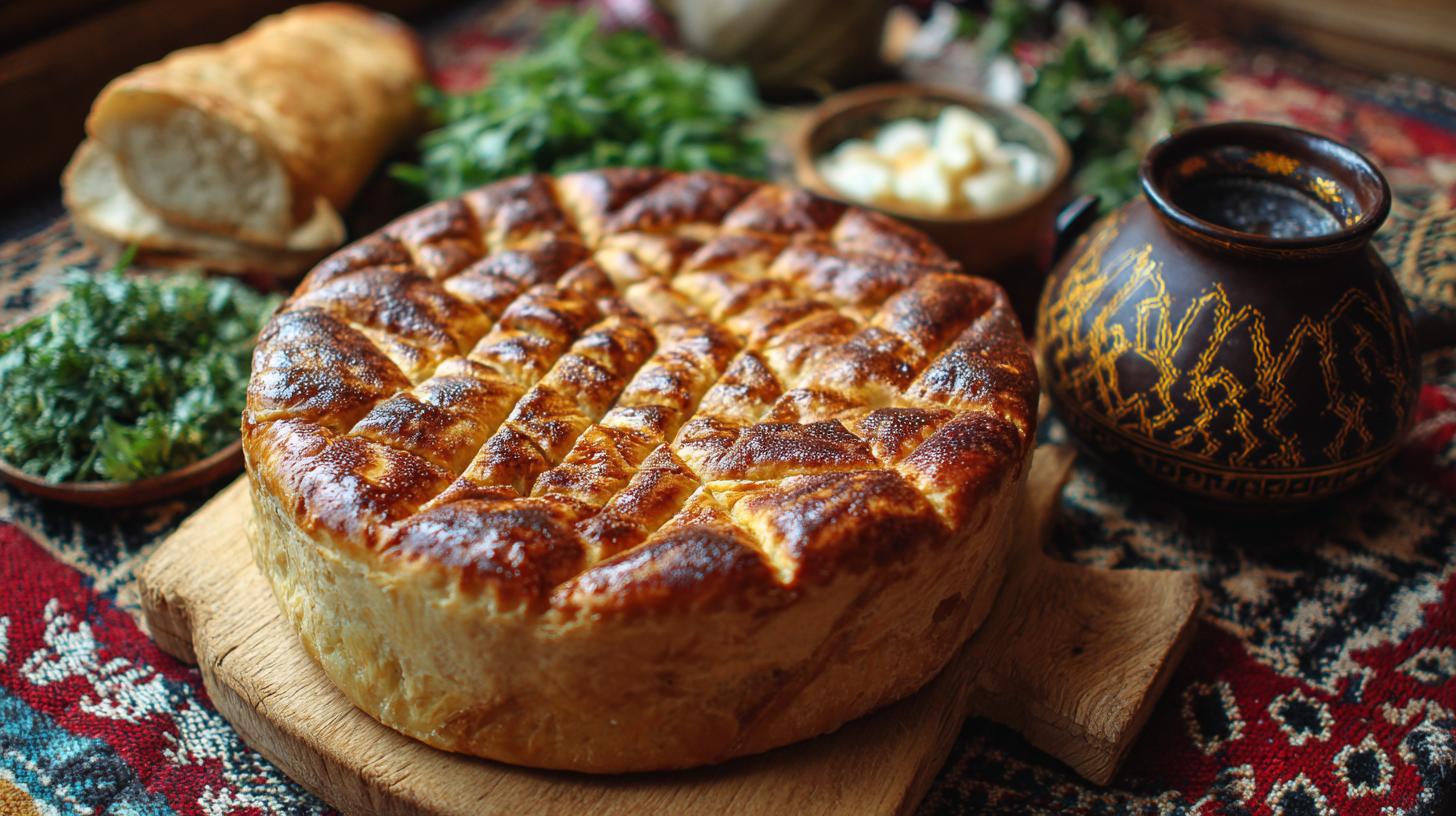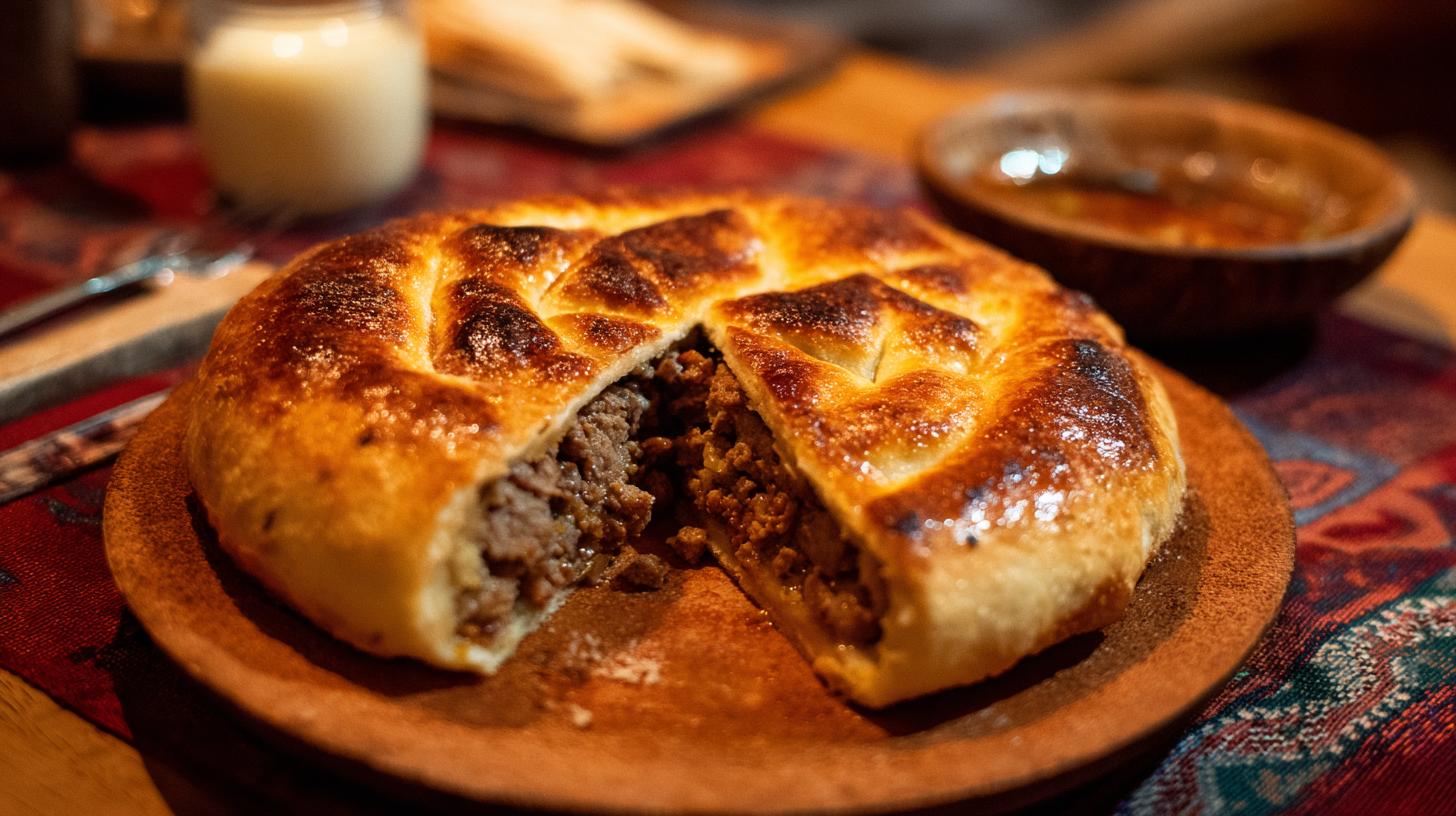Svanetian Kubdari is a traditional delicacy originating from the remote, mountainous region of Svaneti in Georgia. This spiced meat pie from the mountains carries the essence of the area’s rich cultural heritage and culinary traditions. Passed down through generations, kubdari represents more than just food; it is a symbol of community, family gatherings, and the rugged lifestyle of mountain dwellers. Anyone interested in Georgian cuisine or exploring the flavors of the Caucasus will find exploring Svanetian kubdari a rewarding experience.
The Origins and Cultural Importance of Svanetian Kubdari

The Svaneti region is perched high in the Greater Caucasus mountains, characterized by its dramatic landscapes, isolated villages, and a distinct way of life. The cuisine here reflects the tough, self-sufficient lifestyle of the locals, who rely heavily on homegrown and locally sourced ingredients. Svanetian kubdari spiced meat pie from the mountains developed as a hearty, portable, and energy-rich meal suited to these conditions.
Kubdari historically was not just everyday food but also featured in celebrations and festivals. Often prepared in large quantities for gatherings, this pie became a communal dish, bringing families and neighbors together. The recipe, while consistent in base ingredients, can vary subtly between villages, each adding its unique touch to the spiced meat filling.
What Makes the Kubdari Special? Understanding the Ingredients
At its core, Svanetian kubdari is a pie filled with spiced meat, encased in homemade bread dough. The simplicity of the base ingredients belies the complex flavors that emerge from careful seasoning and preparation.
The Choice of Meat
The most common meat used in Svanetian kubdari is pork, particularly cuts that retain some fat to ensure the pie stays moist and flavorful after baking. However, lamb and beef are also used, depending on availability and personal preference. The meat is typically finely chopped or ground to create a uniform texture that blends perfectly with the spices.
Distinctive Svanetian Spices
The defining feature of the kubdari is the spice mix, which encapsulates the essence of the mountain region’s culinary profile. Traditionally, the spices include:
- Utskho suneli (Georgia’s blue fenugreek)
- Ajika (a spicy paste made from chili, garlic, and herbs)
- Coriander seeds or ground coriander
- Black pepper
- Salt
These spices infuse the meat with a robust and aromatic flavor, balancing heat, earthiness, and a subtle bitterness from the fenugreek. The seasoning is crucial for the pie’s signature taste and sets it apart from other meat pies worldwide.
Dough and Baking
The dough for Svanetian kubdari is simple, made from flour, water, yeast, salt, and sometimes a bit of oil or butter. The dough must be rolled out thin enough to bake to a crisp surface without becoming tough, but thick enough to hold the rich filling without breaking.
Once filled, the edges of the dough are meticulously sealed to prevent the juices from leaking during baking. Traditionally, kubdari is baked in a wood-fired oven or on open flames, something that lends the pie a slightly smoky aroma, but it can also be successfully baked in modern kitchen ovens.
Preparing Kubdari: Step-by-Step Guide
If you want to try making Svanetian kubdari yourself, it’s a straightforward process that yields impressive results. Here is a step-by-step overview:
Ingredients Needed
| Ingredient | Quantity | Notes |
|---|---|---|
| Flour | 500g (approx. 4 cups) | All-purpose flour |
| Water | 250 ml (1 cup) | Lukewarm for yeast activation |
| Yeast | 1 tsp (dry active yeast) | Can be substituted with baking powder for a quick version |
| Pork (or preferred meat) | 500g | Chopped or ground |
| Utskho suneli (blue fenugreek) | 1 tbsp | Essential Svanetian spice |
| Ajika | 1 tbsp | For heat and flavor |
| Coriander (ground) | 1 tsp | Optional but recommended |
| Salt & Black Pepper | To taste |
Step 1: Activate the Yeast and Prepare the Dough
Begin by mixing the yeast with lukewarm water and a pinch of sugar (if desired) and let it sit for about 10 minutes until frothy. Next, gradually add the flour and salt to the yeast mixture, kneading until you get a smooth and elastic dough. Cover the dough and let it rise in a warm area for approximately one hour until it doubles in size.
Step 2: Prepare the Meat Filling
In a large bowl, combine the meat with utskho suneli, ajika, coriander, salt, and black pepper. Mix thoroughly to distribute the spices evenly. Some variations may include minced onions or garlic for extra flavor.
Step 3: Assemble the Kubdari
Divide the risen dough into equal portions. Roll each portion into a circle about 20-25 cm in diameter. Place a generous amount of the spiced meat filling in the center of the dough circle. Fold the edges inward, pinching the dough tightly to seal the filling inside. The resulting shape resembles a small round pie.
Step 4: Baking
Place the pies on a baking tray lined with parchment paper or a lightly greased surface. Bake in a preheated oven at 180°C (350°F) for approximately 45 minutes, or until the dough is golden brown and crispy. For the authentic smoky flavor, kubdari may also be cooked in a wood-fired oven where the heat is intense and even.
Serving and Enjoying Svanetian Kubdari
Kubdari is traditionally served hot, right out of the oven. Its hearty filling and crisp crust make it a satisfying meal on its own, perfect for the mountainous climate of the Svaneti region. It pairs well with a side of fresh greens, pickled vegetables, or a light salad to balance the richness of the pie.
Complementary Beverages
In Svaneti, kubdari is often accompanied by traditional Georgian beverages such as:
- Chacha – a strong grape-based spirit
- Georgian red wines – known for their robust and fruity notes
- Herbal teas – soothing and refreshing after a heavy meal
These drinks enhance the overall flavor experience and provide a taste of Georgian hospitality.
Occasions for Kubdari
Kubdari is not restricted to casual meals; it holds significance in social events such as weddings, religious celebrations, and harvest festivals in Svaneti. The pie’s preparation requires time and effort, making it a culinary centerpiece that expresses care and tradition.
The Nutritional Perspective of Svanetian Kubdari
Considering its ingredients, Svanetian kubdari is a high-protein food rich in fats and carbohydrates, designed for energy sustenance in cold mountain climates. The meat provides ample protein, while the spices contribute antioxidants and health benefits known in traditional herbal medicine.
Calorie and Nutrient Estimates
| Component | Approximate Quantity in One 250g Kubdari | Function |
|---|---|---|
| Calories | 600-700 kcal | Energy source |
| Protein | 30-40g | Muscle repair and growth |
| Fat | 25-35g | Energy and flavor carrier |
| Carbohydrates | 50-60g | Quick energy |
For those mindful of dietary intake, kubdari can be enjoyed in moderation and paired with lighter sides to maintain balance. The spices used are low in calories and add not only flavor but also potential digestive benefits.
Variations of Kubdari Across Regions
While Svanetian kubdari from the mountains maintains a core set of ingredients, variations exist within Georgian cuisine and beyond. Some cooks may experiment with different meats, including chicken or even fish in coastal regions, though traditionalists emphasize sticking to pork or beef.
Some variations add local herbs, such as tarragon or parsley, while others might include cheese mixed with the filling for a richer texture. Another popular variation includes the addition of sautéed onions or even small pieces of dried plum to introduce a hint of sweetness.
Comparison Table: Kubdari vs Other Georgian Meat Pies
| Pie | Region | Filling | Spices | Distinguishing Feature |
|---|---|---|---|---|
| Kubdari | Svaneti (Mountains) | Spiced pork or beef | Utskho suneli, ajika | Hearty, rustic, wood-fired baking |
| Khachapuri | Multiple (nationwide) | Cheese, sometimes egg and butter | Mild or no spices | Cheesy, soft bread base |
| Mtsvadi Pie | Various | Grilled meat bits (mtsvadi) | Simple salt and pepper | Usually served as skewered meat, pie variant less common |
This helps illuminate kubdari’s unique place in Georgian cuisine: a meat pie closely tied to a specific region and its traditions, standing apart from Georgia’s widely recognized cheese pies.
The Experience of Eating Kubdari in Svaneti

For travelers and food enthusiasts exploring Svaneti, tasting Svanetian kubdari spiced meat pie from the mountains is an immersive cultural experience. Many guesthouses and local eateries pride themselves on serving authentic kubdari, often accompanied by stories about the recipe’s history and preparation methods.
Eating kubdari in Svaneti often means savoring it alongside spectacular mountain views, fresh mountain air, and the warmth of local hospitality. The pie’s filling speaks to the resourcefulness of Svan family cooks who needed a filling, energy-dense meal that could last through long workdays in difficult terrain.
Preserving and Sharing Traditional Recipes in Modern Times

With increasing interest in traditional cuisines worldwide, there is a growing movement to preserve recipes like Svanetian kubdari. Chefs both inside Georgia and outside its borders are experimenting with kubdari, sometimes adding modern twists but honoring the foundational spiced meat and bread combination.
Efforts by culinary schools in Georgia, food festivals, and cultural programs contribute to sustaining the knowledge of how to prepare kubdari authentically. Moreover, the story of the spiced meat pie from the mountains serves as a window into the larger Svan cultural identity, helping keep these mountain traditions relevant in the 21st century.
Getting Ingredients Outside of Svaneti
For those living outside Georgia but interested in making or tasting kubdari, sourcing key ingredients can be a challenge yet not impossible. Specialty spice shops, online stores, and international markets sometimes stock essential Georgian spices such as utskho suneli and ajika paste.
Here are some tips on ingredient substitutions if authentic items are unavailable:
- Utskho Suneli: Substitute with a mix of fenugreek powder and toasted coriander seeds.
- Ajika: Use a chili-garlic paste mixed with smoked paprika and fresh herbs.
- Meat: High-quality pork shoulder or brisket can replicate the fat content.
While these substitutions may not capture the exact flavor of Svanetian kubdari, they allow home cooks outside Georgia to approximate the experience of the spiced meat pie from the mountains.
Final Thoughts on Svanetian Kubdari
Exploring the story, preparation, and cultural importance of Svanetian kubdari reveals far more than a recipe for a savory pie. It opens a window into the highlands of Georgia, showcasing how geography, history, and tradition combine to shape culinary identity. The spiced meat pie from the mountains is a testament to the resilience of mountain communities and their ability to adapt simple ingredients into deeply flavorful and satisfying food.
By trying or learning about Svanetian kubdari, one participates in preserving a unique aspect of Georgian culture—a culture that values shared meals, seasonings grown on mountain slopes, and the art of baking bread wrapped around the heart of the mountain’s harvest and livestock.
Whether enjoyed in a remote Svan village or recreated far from the Caucasus, kubdari invites you to savor a piece of the mountains’ spirit and the warmth of Georgian hospitality.